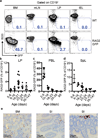Microbial colonization influences early B-lineage development in the gut lamina propria
- PMID: 23965619
- PMCID: PMC3807868
- DOI: 10.1038/nature12496
Microbial colonization influences early B-lineage development in the gut lamina propria
Abstract
The RAG1/RAG2 endonuclease (RAG) initiates the V(D)J recombination reaction that assembles immunoglobulin heavy (IgH) and light (IgL) chain variable region exons from germline gene segments to generate primary antibody repertoires. IgH V(D)J assembly occurs in progenitor (pro-) B cells followed by that of IgL in precursor (pre-) B cells. Expression of IgH μ and IgL (Igκ or Igλ) chains generates IgM, which is expressed on immature B cells as the B-cell antigen-binding receptor (BCR). Rag expression can continue in immature B cells, allowing continued Igκ V(D)J recombination that replaces the initial VκJκ exon with one that generates a new specificity. This 'receptor editing' process, which can also lead to Igλ V(D)J recombination and expression, provides a mechanism whereby antigen encounter at the Rag-expressing immature B-cell stage helps shape pre-immune BCR repertoires. As the major site of postnatal B-cell development, the bone marrow is the principal location of primary immunoglobulin repertoire diversification in mice. Here we report that early B-cell development also occurs within the mouse intestinal lamina propria (LP), where the associated V(D)J recombination/receptor editing processes modulate primary LP immunoglobulin repertoires. At weanling age in normally housed mice, the LP contains a population of Rag-expressing B-lineage cells that harbour intermediates indicative of ongoing V(D)J recombination and which contain cells with pro-B, pre-B and editing phenotypes. Consistent with LP-specific receptor editing, Rag-expressing LP B-lineage cells have similar VH repertoires, but significantly different Vκ repertoires, compared to those of Rag2-expressing bone marrow counterparts. Moreover, colonization of germ-free mice leads to an increased ratio of Igλ-expressing versus Igκ-expressing B cells specifically in the LP. We conclude that B-cell development occurs in the intestinal mucosa, where it is regulated by extracellular signals from commensal microbes that influence gut immunoglobulin repertoires.
Figures




Comment in
-
Immunology: B-cell development in the gut.Nature. 2013 Sep 5;501(7465):42-3. doi: 10.1038/nature12551. Epub 2013 Aug 21. Nature. 2013. PMID: 23965621 No abstract available.
-
B cell development: a window of opportunity.Nat Rev Immunol. 2013 Oct;13(10):707. doi: 10.1038/nri3540. Nat Rev Immunol. 2013. PMID: 24064517 No abstract available.
References
-
- Jung D, Giallourakis C, Mostoslavsky R, Alt FW. Mechanism and control of V(D)J recombination at the immunoglobulin heavy chain locus. Annu Rev Immunol. 2006;24:541–570. - PubMed
-
- Yu W, et al. Continued RAG expression in late stages of B cell development and no apparent re-induction after immunization. Nature. 1999;400:682–687. - PubMed
-
- Pelanda R, et al. Receptor editing in a transgenic mouse model: site, efficiency, and role in B cell tolerance and antibody diversification. Immunity. 1997;7:765–775. - PubMed
Publication types
MeSH terms
Substances
Associated data
- Actions
- Actions
Grants and funding
LinkOut - more resources
Full Text Sources
Other Literature Sources
Molecular Biology Databases
Research Materials

